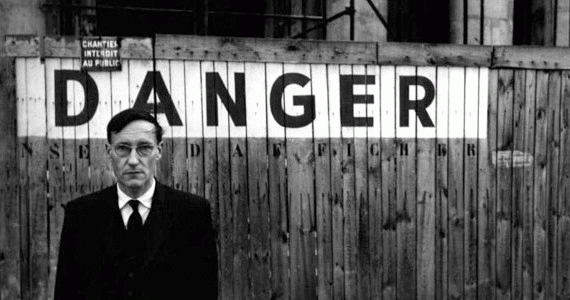
Luis Felipe Rojas, 5 July 2105 — For a week I have been steeped in the acidic prose of William S. Burroughs. It is neither a debut novel nor something reissued in the wake of legalization of gay marriage in the United States. The work is an edition released by Anagrama, a Barcelona-based publishing house, and it comes without frills or pretensions. The faded cover shows Burroughs under a blue visor, almost dissolving into a watery background of opaque tones. Reading it took me longer than I would have thought.
Those looking for a world of good manners and polite expressions — or even the insane for that matter — might not want to tread near this literary specimen. In one-hundred thirty tightly packed pages, Burroughs bangs out a chronicle of his alter ego Lee’s travels through the most sordid and filthy corners of Mexico, Panama and Ecuador. This is definitely not everyone’s idea of literature, as Queer attests.
The homoerotic experiences of the intense Lee and his brash companion Allerton — a young man aroused not by other human bodies but by his own flesh and entrails — form a portrait that is somewhat darker than the story of two homosexuals simply trying to live a “normal” life in a Mexico that is more than a little bit macho, which makes it all the more alluring. Their goal is to find what has brought them there: Yage, a natural substance that promises total control over their thoughts.
The story takes place in a bar where the two have met up with an elderly man, Guidry. After a few beers, Guidry initiates a conversation:
“Did I tell you how I made the cop on the beat? He’s the vigilante, the watchman out there where I live. Every time he sees the light on in my room, he comes in for a shot of rum. Well, about five nights ago he caught me when I was drunk and horny, and one thing led to another and I ended up showing him how the cow ate the cabbage.”
A character narrates without an intended audience. A “pesky reporter” trying be a wise-ass casts doubt on Oriental wisdom by asking an old man in a trance — colored smoke streaming out of his nose — who has made cosmic contact: “Will there be war with Russia, Mahatma? Will Communism destroy the civilized world? Is the soul immortal? Does God exist?”
The response is priceless and Burroughs delineates it in his cool, agile prose: “The Mahatma opens his eyes and compresses his lips and spits two long, red streams of betel nut juice out through his nose holes. It runs down over his mouth and he licks it back in with a long, coated tongue and says, ‘How in the fuck should I know?’ The acolyte says, ‘You heard the man. Now cut. The Swami wants to be alone with his medications.’ Come to think of it, that is the wisdom of the East. The Westerner thinks there is some secret he can discover. The East says, ‘How the fuck should I know?'”
Upon its release, the British novelist Martin Amis said that Burroughs had “written a thoughtful and sensitive study of unrequited love.” Recently the Spanish newspaper El País published an article, “The House Where Burroughs Killed,” a story about an apartment in Mexico where the writer shot his wife. It describes a site which has become a place of pilgrimage for Burroughs’ fans and other oddballs who make up the human species.
The author of Naked Lunch was charged with murder and sent to jail in Lecumberri, a place where years later the Colombian writer Alvaro Mutis would also be imprisoned. Here a key protagonist, the Mexican attorney Bernabé Jurado (“the Jack of All Trades, clever corrupter of judges,” according to Garcia Robles) appears on the scene. After only 13 days in prison the shyster lawyer manages to get his client released by “proving” it was an accident. That was the version Burroughs offered while still behind bars to La Prensa, a tabloid newspaper that thought it was interviewing just another crackpot.
“My wife had had a few drinks. I took the gun to show it to my friends. The gun slipped and fell, hit a table and discharged. Everything was purely accidental,” said Burroughs, as reported in the excellent article by Juan Diego Quesada for the Madrid newspaper.
Sixty-four years later, residents of the Mexico City building — two little old ladies — are besieged by curious visitors, sticking their noses in, hoping to learn ever more about a troubled writer who shocked so many in the latter half of the twentieth century.
“There are those who believe he was a vile murderer crowned with a halo of romanticism but they are a minority,” concludes the El País reporter. “Bernardo Fernández is the author and illustrator of the graphic novel Uncle Bill, which is based on Burroughs adventures in Mexico City. Upon leaving the office of his psychoanalyst one Monday, Fernández peered through the entry to the building but it was too dark to go for a stroll inside. He fantasized entering the apartment, having coffee with its tenants and taking some photos. But he did not dare because he knew that the response of the sisters and their five dogs would be the same as always: ‘Get out of here.’ The mystery of Burroughs remains hidden behind that door.”
*Translator’s note: English-language title of a novella by William S. Burroughs. Written in 1951 and 1852, it was not published until 1985. The complete work is currently available for free online:
https://colectivotijeras.files.wordpress.com/2013/06/burroughs-william-s-queer.pdf
